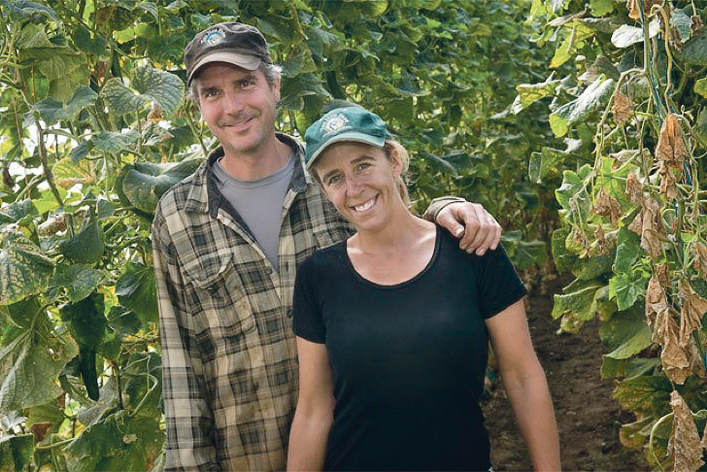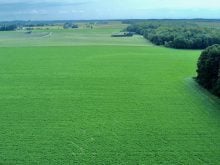KELOWNA, B.C. — During a first-of-its kind conference in Kelowna earlier this year, producers, soil health experts and advocates gathered to discuss the future of farming.
The First Canadian Summit on Climate Action in Food Systems focused on regenerative agriculture, looking at how farmers can be part of the solution in helping mitigate climate change.
The goal of the event was to hear different voices in the industry and accept that people are at different stages in improving their soils, but one presentation made the case that sustainability isn’t enough.
Finian Makepeace, co-founder of Kiss the Ground, which advocates for regenerative agriculture and healthy soil, argued that the practice, in which farmers improve soil carbon levels, is the way to go.
“We all need this to go forward in a big way,” he told the October conference.
“Regeneration can mitigate those climate change impacts.”
But is regenerative achievable for everyone, and what levels of regeneration are deemed acceptable?
These are tough questions to answer as more farmers continue to hear about the regenerative movement.

They could unlock ways to help mitigate climate change, considering that more carbon would be sequestered from the atmosphere and into the soil, but does it make financial sense? If a farmer can’t make a living, then is it really sustainable? Can it be done on a broad scale?
Lack of market premiums and demand, as well as the challenges faced when changing old habits may be why it hasn’t been adopted by every farm.
Presenters wrestled with these questions and ideas throughout the conference.
Some said regenerative agriculture is the only solution, while others argued no system is truly sustainable.
Instead, some said, small changes here and there should be considered wins. It’s a win if farmers use less herbicides, they said, a win if they till less and even a win if they go organic.
Read Also

Canadian Food Inspection Agency red tape changes a first step: agriculture
Farm groups say they’re happy to see action on Canada’s federal regulatory red tape, but there’s still a lot of streamlining left to be done
All types of producers are going to need to come to the table, said the organizers, so they can understand how each other’s systems work. A respectful debate is necessary.
There can sometimes be a divide between producers on the issue, especially between those who farm conventionally and those who don’t.
“We wanted to create a safe conversation where everyone can come to the table,” said Tamara McLellan, co-host of the conference.
“We have people here talking about how they still spray herbicide and it’s an approach that works for them. Great, at least we are having a conversation about it.”
However, conference organizers said many producers should change as more consumers demand food that is thought to benefit the climate.
Brenda Tjaden, founder of Sustainable Grain and an agricultural economist, said there are some bad actors out there, suggesting tight-to-no rotations aren’t acceptable.
“We all snicker about throwing soybeans on the same piece of land for eight years and laugh about hardly rotating canola, but I don’t think these conversations are funny,” said Tjaden, who co-founded FarmLink Marketing Solutions before leaving the company.
“There is amazing farming going on out there and deplorable farming going on out there,” she said.
She said lots of farmers feel they have no choice but to use chemical sprays, given the crops they grow, but pointed to other solutions that show herbicides aren’t the be-all and end-all.
She sees regenerative practices, even if it’s only through intercropping, green manures or no-till, as a way forward where chemicals are used less often and returns improve.
“We really believe in all types of farming systems and everyone has a seat at the table when we talk about solutions, but it has to be really based on transparency,” she said.
“Let’s let the consumer decide.”

During the conference, numerous producers, who operate large and small operations, shared what they do to improve soil.
Some use chemicals while others have 15 crops in rotation, but they all made the case that regenerative practices are possible to implement despite the initial hurdles.
“We started our regenerative model out of necessity and financial necessity after years of excessive moisture on our farm, which was causing us not to be profitable,” said Brooks White, who farms near Pierson, Man., with Borderland Agriculture.
“We needed to find a way to make our soil more resilient and implement different practices,” he said.
Gillian Flies, who owns The New Farm in southern Ontario and is president of Canadian Organic Growers, said she is optimistic that small regenerative practices can have big economic benefits because they could help stem wet and dry spells.
“Those folks who aren’t in it to save the environment will join the program because they are able to see economic benefit,” she said.
White said lots of different kinds of farmers adopt regenerative for their own purposes, but everyone is striving for the same goal.
For him, regenerative practices ultimately helped his balance sheet, and he believes other producers will follow suit for the economic incentives.
“For change to happen on large-scale farms, it has to be economically viable,” he said. “It has to be on our two feet and, ultimately, I think that’s what is driving people to move that way because of the economic incentive.”
Shane Paterson, director of trade and transportation at Paterson GlobalFoods, said farmers are already doing a good job, and he believes economics will drive change.
He said collaboration is key for when environmentally conscience markets emerge.
“When change is pushed upon (us) with no incentive and no understanding, that is what breaks the system, in my mind,” he said. “It has to be collaborative.”
During the conference, presenters offered ways to help producers inch toward regenerative practices.
They include increasing plant diversity, no- to minimal-till, cover crops, green manure, intercropping, re-integrating livestock, adding shelter belts and being more precise with spraying and treatments to reduce use.
















